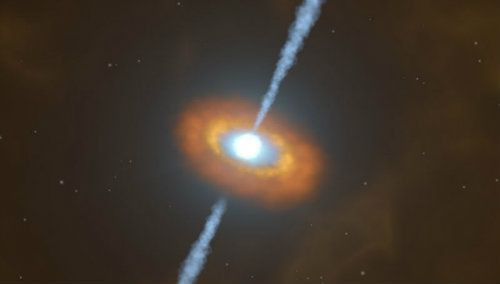Scientists Provide Update On First Confirmed Heartbeat Of Supermassive Black Hole

KEY POINTS
- A team of scientists re-observed the first confirmed heartbeat of a supermassive black hole
- The black hole's heartbeat is a repeating signal that occurs every hour
- Scientists believe the heartbeat is formed as the black hole feeds on cosmic material
Scientists have discovered that the first confirmed heartbeat produced by a supermassive black hole is still active and strong over a decade after it was first observed. According to the scientists, the heartbeat, or repeating signal, was produced by the black hole’s accretion disk as it expands and contracts.
The observation was made by scientists from the Chinese Academy of Sciences and Durham University. Their findings were presented in a new study published in the journal Monthly Notices of the Royal Astronomical Society.
The study focused on a supermassive black hole located at the center of a galaxy identified as RE J1034+396, which is about 600 million light-years from Earth’s neighborhood.
In 2007, the scientists detected a repeating signal coming from the black hole. According to their observations, which were made using X-ray satellites, the signal repeated itself every hour. Due to its frequency, the scientists referred to the signal as the black hole’s heartbeat.
Unfortunately, in 2011, the satellites used by the scientists to observe the signal were blocked by the Sun, preventing them from monitoring the heartbeat for many years.
In 2018, the scientists were able to once again observe the repeating signal using the XMM-Newton X-ray satellite of the European Space Agency. They were surprised to learn that even after over a decade, the supermassive black hole’s heartbeat is still active.
According to the scientists, the repeating signal might be coming from the black hole’s accretion disk, which is a swirling disk of cosmic materials that fall into the black hole. The scientists believe that the signal is produced as the black hole feeds on the material from the accretion disk.
Currently, the only black hole that is known to produce its own repeating signal is a stellar-mass black hole within the Milky Way galaxy.
“The main idea for how this heartbeat is formed is that the inner parts of the accretion disc are expanding and contracting,” Chris Done, the co-author of the study, said in a statement.
“The only other system we know which seems to do the same thing is a 100,000 times smaller stellar-mass black hole in our Milky Way, fed by a binary companion star, with correspondingly smaller luminosities and timescales. This shows us that simple scalings with black hole mass work even for the rarest types of behavior,” he continued.
© Copyright IBTimes 2025. All rights reserved.




















